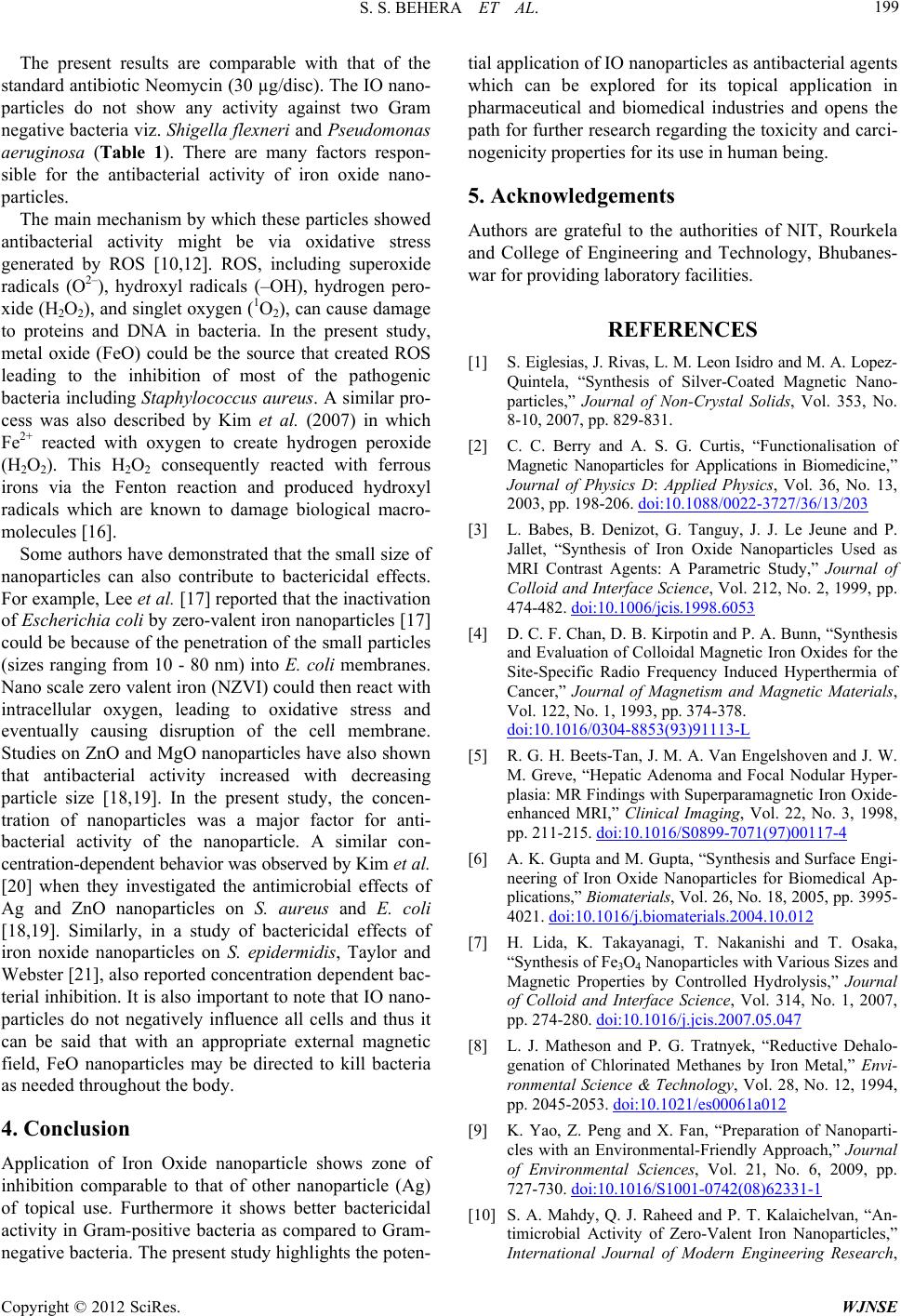
S. S. BEHERA ET AL. 199
The present results are comparable with that of the
standard antibiotic Neomycin (30 µg/disc). The IO nano-
particles do not show any activity against two Gram
negative bacteria viz. Shigella flexneri and Pseudomonas
aeruginosa (Table 1). There are many factors respon-
sible for the antibacterial activity of iron oxide nano-
particles.
The main mechanism by which these particles showed
antibacterial activity might be via oxidative stress
generated by ROS [10,12]. ROS, including superoxide
radicals (O2–), hydroxyl radicals (–OH), hydrogen pero-
xide (H2O2), and singlet oxygen (1O2), can cause damage
to proteins and DNA in bacteria. In the present study,
metal oxide (FeO) could be the source that created ROS
leading to the inhibition of most of the pathogenic
bacteria including Staphylococcus aureus. A similar pro-
cess was also described by Kim et al. (2007) in which
Fe2+ reacted with oxygen to create hydrogen peroxide
(H2O2). This H2O2 consequently reacted with ferrous
irons via the Fenton reaction and produced hydroxyl
radicals which are known to damage biological macro-
molecules [16].
Some authors have demonstrated that the small size of
nanoparticles can also contribute to bactericidal effects.
For example, Lee et al. [17] reported that the inactivation
of Escherichia coli by zero-valent iron nanoparticles [17]
could be because of the penetration of the small particles
(sizes ranging from 10 - 80 nm) into E. coli membranes.
Nano scale zero valent iron (NZVI) could then react with
intracellular oxygen, leading to oxidative stress and
eventually causing disruption of the cell membrane.
Studies on ZnO and MgO nanoparticles have also shown
that antibacterial activity increased with decreasing
particle size [18,19]. In the present study, the concen-
tration of nanoparticles was a major factor for anti-
bacterial activity of the nanoparticle. A similar con-
centration-dependent behavior was observed by Kim et al.
[20] when they investigated the antimicrobial effects of
Ag and ZnO nanoparticles on S. aureus and E. coli
[18,19]. Similarly, in a study of bactericidal effects of
iron noxide nanoparticles on S. epidermidis, Taylor and
Webster [21], also reported concentration dependent bac-
terial inhibition. It is also important to note that IO nano-
particles do not negatively influence all cells and thus it
can be said that with an appropriate external magnetic
field, FeO nanoparticles may be directed to kill bacteria
as needed throughout the body.
4. Conclusion
Application of Iron Oxide nanoparticle shows zone of
inhibition comparable to that of other nanoparticle (Ag)
of topical use. Furthermore it shows better bactericidal
activity in Gram-positive bacteria as compared to Gram-
negative bacteria. The present study highlights the poten-
tial application of IO nanoparticles as antibacterial agents
which can be explored for its topical application in
pharmaceutical and biomedical industries and opens the
path for further research regarding the toxicity and carci-
nogenicity properties for its use in human being.
5. Acknowledgements
Authors are grateful to the authorities of NIT, Rourkela
and College of Engineering and Technology, Bhubanes-
war for providing laboratory facilities.
REFERENCES
[1] S. Eiglesias, J. Rivas, L. M. Leon Isidro and M. A. Lopez-
Quintela, “Synthesis of Silver-Coated Magnetic Nano-
particles,” Journal of Non-Crystal Solids, Vol. 353, No.
8-10, 2007, pp. 829-831.
[2] C. C. Berry and A. S. G. Curtis, “Functionalisation of
Magnetic Nanoparticles for Applications in Biomedicine,”
Journal of Physics D: Applied Physics, Vol. 36, No. 13,
2003, pp. 198-206. doi:10.1088/0022-3727/36/13/203
[3] L. Babes, B. Denizot, G. Tanguy, J. J. Le Jeune and P.
Jallet, “Synthesis of Iron Oxide Nanoparticles Used as
MRI Contrast Agents: A Parametric Study,” Journal of
Colloid and Interface Science, Vol. 212, No. 2, 1999, pp.
474-482. doi:10.1006/jcis.1998.6053
[4] D. C. F. Chan, D. B. Kirpotin and P. A. Bunn, “Synthesis
and Evaluation of Colloidal Magnetic Iron Oxides for the
Site-Specific Radio Frequency Induced Hyperthermia of
Cancer,” Journal of Magnetism and Magnetic Materials,
Vol. 122, No. 1, 1993, pp. 374-378.
doi:10.1016/0304-8853(93)91113-L
[5] R. G. H. Beets-Tan, J. M. A. Van Engelshoven and J. W.
M. Greve, “Hepatic Adenoma and Focal Nodular Hyper-
plasia: MR Findings with Superparamagnetic Iron Oxide-
enhanced MRI,” Clinical Imaging, Vol. 22, No. 3, 1998,
pp. 211-215. doi:10.1016/S0899-7071(97)00117-4
[6] A. K. Gupta and M. Gupta, “Synthesis and Surface Engi-
neering of Iron Oxide Nanoparticles for Biomedical Ap-
plications,” Biomaterials, Vol. 26, No. 18, 2005, pp. 3995-
4021. doi:10.1016/j.biomaterials.2004.10.012
[7] H. Lida, K. Takayanagi, T. Nakanishi and T. Osaka,
“Synthesis of Fe3O4 Nanoparticles with Various Sizes and
Magnetic Properties by Controlled Hydrolysis,” Journal
of Colloid and Interface Science, Vol. 314, No. 1, 2007,
pp. 274-280. doi:10.1016/j.jcis.2007.05.047
[8] L. J. Matheson and P. G. Tratnyek, “Reductive Dehalo-
genation of Chlorinated Methanes by Iron Metal,” Envi-
ronmental Science & Technology, Vol. 28, No. 12, 1994,
pp. 2045-2053. doi:10.1021/es00061a012
[9] K. Yao, Z. Peng and X. Fan, “Preparation of Nanoparti-
cles with an Environmental-Friendly Approach,” Journal
of Environmental Sciences, Vol. 21, No. 6, 2009, pp.
727-730. doi:10.1016/S1001-0742(08)62331-1
[10] S. A. Mahdy, Q. J. Raheed and P. T. Kalaichelvan, “An-
timicrobial Activity of Zero-Valent Iron Nanoparticles,”
International Journal of Modern Engineering Research,
Copyright © 2012 SciRes. WJNSE